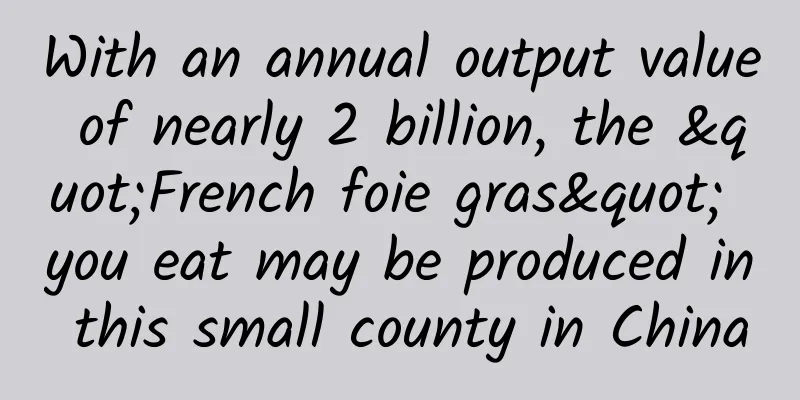With an annual output value of nearly 2 billion, the "French foie gras" you eat may be produced in this small county in China

|
Goose liver, as an offal food, is not unfamiliar in the Chinese diet. Braised goose liver is even a well-known stewed dish in Chaoshan area. However, if you mention "French goose liver", there are probably not many people who are familiar with it, and most of the knowledge about it is limited to keywords such as "France", "high-end Western restaurant" and "expensive". However, what many people may not realize is that nowadays, in China’s Western restaurants, Japanese restaurants, high-end restaurants, and even supermarkets and e-commerce platforms, about one-third of the “French foie gras” you eat comes from Huoqiu, a county in Lu’an City, Anhui Province [1] . How did Huoqiu, Anhui, come to account for half of the market share of “domestic French foie gras”? Through this small piece of goose liver, we can get a glimpse of the epitome of how domestic specialty production areas seize opportunities at home and abroad and gradually achieve industrial transformation and development. In this process, the help of domestic technical personnel is indispensable. Copyright images in the gallery. Reprinting and using them may lead to copyright disputes. The aristocratic history of foie gras Unlike Chinese foie gras, French foie gras has been endorsed by generations of dignitaries and finally grew into a noble appearance. It is known as one of the "three great delicacies of the world" along with caviar and truffles. There are many celebrities in history who are fond of foie gras, such as Caesar, who is considered to be the first celebrity in history to declare that he loves foie gras, and Louis XVI, whose promotion made the name of foie gras widely known and eventually developed into a French specialty. This small piece of foie gras is indeed a tempting delicacy. The "goose liver" used in "French foie gras" is not ordinary goose liver, but fatty liver (French name Foie gras. According to French law, foie gras is defined as the liver obtained by fattening a duck or goose by stuffing). It is traditionally made from the goose liver of Moulard duck, and in recent years some places have also used Perigord duck. In order to achieve the desired taste, "French foie gras" often cannot grow naturally. People need to force-feed the geese after they grow to a certain stage to make the goose's liver plump. The process of stuffing goose. The picture comes from the Internet The fat content of goose liver raised in this way is 40% to 60%. Under the effect of fat, the texture is as smooth as cream, and it also has a unique nutty aroma mixed with sweetness. Moreover, although it has a high fat content, most of it is unsaturated fatty acids that are beneficial to the human body (accounting for 65% to 68%). The lecithin content in every 100 grams of goose liver is 4.5 to 7 grams, and the deoxyribonucleic acid content is 9 to 13.5 grams [2]. The nutritional value also adds a fuller filter to "French goose liver". It is said that the most expensive foie gras in the world can be sold for 4,000 yuan per kilogram. "French foie gras" made in China Since the 1980s, China has become a member of the "French foie gras" production army. At that time, it was the early stage of reform and opening up. The country vigorously promoted investment and called for strengthening foreign technological cooperation. Taking advantage of this favorable situation, the seedlings of the Landes goose were introduced to China. In 1986, Changyi, Shandong Province, took the lead in introducing French Landes geese. In 1990, it began to export high-quality goose liver to Japan. Subsequently, goose liver from Linqu, Shandong Province was also continuously exported to Japan. [3] Sensing business opportunities, many people from other places also began to visit Shandong to learn about goose farming experience. Huoqiu in Anhui is one of them. Huoqiu is located in Lu'an, a well-known goose breeding area in China. It is located in the Dabie Mountains, with abundant water and grass, vast hilly grasslands, and is an ideal place for waterfowl breeding and reproduction. Locals have a long tradition of raising geese and have rich breeding experience. Moreover, Huoqiu's climate is similar to that of the Landes goose in France. Huoqiu map, with many lakes. Image source: National Geographic Public Service Platform But it is not easy for the Langde goose to settle in Huoqiu. As one of the earliest goose farmers in the county, Hu Jianyuan recalled: "The first batch was more than 1,000 gooses, which we raised as treasures. At that time, I didn't even have an air conditioner installed. After buying the goslings, we installed air conditioners for the goslings to raise them and to ensure their survival rate." Huoqiu has a geese breeding history of more than 20 years since the initial introduction of Langde geese. Now, Huoqiu County raises and processes more than 4 million Langde geese annually, produces more than 5,000 tons of goose fat liver and 18,000 tons of goose by-products annually, with an annual output value of nearly 2 billion yuan, making it one of the largest county-level goose liver production and processing bases in the country . "Technology Mission" The development of Huoqiu goose liver cannot be separated from the help of domestic technical personnel. It usually takes 90 days for a Landes goose to grow from a gosling to an adult goose. When it is about 35 days old, one or both of its wing joints may shift or flip up, which is the so-called "goose wing flipping syndrome". This symptom affects the natural mating of male and female geese, and they cannot be kept for breeding. When they are artificially fed, they will take up more space in the cage or rub against each other, causing stress in the goose and affecting its own growth. In order to solve this problem, Xia Lunzhi, a researcher at the Institute of Animal Husbandry and Veterinary Medicine of Anhui Academy of Agricultural Sciences, and his team members developed a compound feed additive for preventing "goose wing flapping disease", which effectively reduced the incidence of "goose wing flapping disease". This technology has been protected by a national invention patent. Image source: Anhui Academy of Agricultural Sciences There used to be a very thorny problem in the breeding of Landes geese. Goose livers need to be force-fed, but during the feeding process, due to the rough feeding action, unbalanced nutrition of the feeders, inappropriate temperature and humidity in the house, etc., the geese may have a strong stress response, and nearly 20% of the goose livers will have blood spots of varying sizes, which seriously affects the quality of the goose liver. Xia Lunzhi and his team have also developed a compound feed additive for preventing the occurrence of hemorrhagic plaques in the foie gras of Landes geese . This focuses on protecting the elasticity and toughness of blood vessel walls, reducing the incidence of hemorrhagic plaques in the foie gras of goose from the original 10% to 15% to the current less than 2%. This technology has also been granted national invention patent protection. However, the development of the Landais goose industry now also faces a difficult problem that needs to be solved urgently - the degeneration of the Landais goose breed. An entrepreneur who has been engaged in Landes goose breeding for more than 20 years expressed his anxiety: "In recent years, our Landes goose seedlings are basically imported from other places, and the development of the industry has long been restrained by others." "The degeneration of the breed has led to a decrease in the disease resistance of the Landes goose, and at the same time, the feed-to-liver ratio has decreased and the feeding period has been extended." With the popularity of "cranberries" and the subsequent "agricultural survey", Huoqiu foie gras has ushered in an unexpected wave of traffic and attention this year, which has also brought new opportunities for the development of Huoqiu's foie gras industry. Zhu Renjun, chairman of Huoqiu County Renjun Poultry Breeding Co., Ltd., said: "Taking advantage of this wave of traffic, we are also preparing to focus on standardization and refinement. By 2024, we want to build a 1 million-level sterile goose liver cooked food workshop, improve product quality standards, and achieve the company's upgrade and development." Now, Huoqiu County has carried out industry-university-research cooperation with scientific research institutes and universities such as Anhui Agricultural University and Anhui Academy of Agricultural Sciences to carry out research and development of "goose breed purification" technology, develop more series of deep-processed products such as goose fatty liver, and formulate unified and standardized industry technical standards and operating procedures. Perhaps in the near future, we will have our own cultivated Landes goose seedlings, and this expensive Western ingredient will enter more ordinary households. Reference Links [1] Anhui French foie gras relies on strong industrial chain strength to "break the circle" http://ydah.china.com.cn/2024-03/25/content_42734278.htm [2] Tu Guozhong. Effects of starting body weight and feeding fat on the performance of Landes goose fat liver[D]. Nanjing Agricultural University, 2011. DOI: 10.7666/d.Y2039044. [3] Chen Yaowang. A brief history and prospects of goose liver nutrition production [C]//Proceedings of the First China Waterfowl Development Conference - Progress in China's Waterfowl Industry. 2005. [4] Huoqiu, Anhui: Goose business in the goose liver town https://news.cctv.com/2024/01/26/ARTIwL2SoRDMyHVCB5UWUzmy240126.shtml [5] The legendary journey of a piece of "French" foie gras - a visit to Mengji Town, the "hometown of foie gras" https://new.qq.com/rain/a/20240130A08ES400 [6] National Agricultural Survey! French foie gras is produced in Anhui https://news.sciencenet.cn/htmlnews/2024/1/515889.shtm Planning and production Author: Yixiao Popular Science Creator Review | Zhong Kai, Director of Kexin Food and Health Information Exchange Center Planning丨Yang Yaping Editor: Yang Yaping Proofread by Xu Lailinlin |
<<: World Asthma Day | Asthma is not a trivial matter, don’t let negligence cost you your life!
>>: Regarding solar flares, all your concerns are addressed at once
Recommend
Douyin live streaming: Ten rules for traffic
Ten military rules for traffic ecology: 1. Douyin...
Tik Tok data-based operation, promotion and analysis skills!
Today I will give you an in-depth analysis of Dou...
Uncovering the secrets of Asia’s “water tower”: majestic yet fragile
Your browser does not support the video tag The Q...
Dunhuang murals have become "like crispy dough". How can restorers save this world treasure?
The topic of "How difficult is it to protect...
Detailed explanation of the use and properties of three types of animations in App development
[[437158]] This article is reprinted from the WeC...
APP channel promotion: How to conduct channel evaluation efficiently?
How can channel acquisition practitioners elimina...
Lumbar disc herniation! Back pain! Huaxi doctors teach you these tips to protect your waist! Simple and cost-effective
Other people's resume: Outstanding academic p...
Nanjing tea service 2021 old place recommendation, trustworthy
Nanjing Tea Service Studio: [191.9211.0426] Weidi...
Once you are over this age, carotid artery plaque will come to you! Severe cases can cause stroke, so don't take it lightly!
During a routine annual physical examination, Ms....
Do you think this belly button is a bit scary?
There are many strange phobias in the world, such...
Will using the air conditioner too much cause "facial nerve paralysis"? Learn about this disease in one article!
In the hot summer, if you try to cool down after ...
You can’t tear it off, and you can’t eat it. What are the stickers on fruits used for?
Many people are used to peeling the stickers off ...
Brand layout: How to use the strategy center to do market analysis?
For TOP brands, market analysis is a very importa...
Breaking the world record! This time it’s a post-00s generation
Recently, the topic "Post-00s want to break ...









